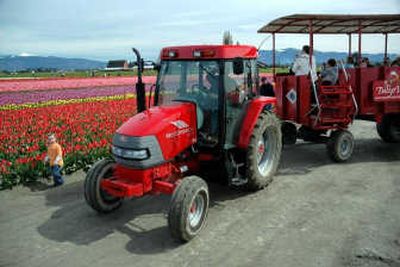Tulip fields an unforgettable display

The fields are splashed with vivid colors. Solid fields and rows of yellow, red, deep purples, white, pinks and orange surround the farm buildings. In the distance, the snow-capped Cascade Mountains dominated by Mount Adams frame the fields of tulips and barns. The sight is unforgettable in Skagit Valley, Washington.
Considered one of Washington state’s best festivals, the Skagit Valley Tulip Festival has recently been included in the book, “1,000 Places to See Before You Die” by Patricia Schultz. Acres and acres of fields with colored flowering crops can be found here. This is a place to go in the spring. You only need to go once to remember the sights but most visitors come back again.
It has been described as a field of dreams. There are millions of flowering tulips, daffodils and irises to feast the eyes on. The crop is a multimillion-dollar commercial venture for the local farmers from the sale of bulbs and flowers. It’s a win-win situation for all involved in the Skagit Valley. The farmers have a cash crop, the local towns reap the tourist dollars and the visitors revel in the annual color show in the fields.
Each year the weather can influence the bloom time for the crop. The crops can be late, early, or the various flowers may mature at different times. There is a Web site and a telephone number to get an updated condition of the crops. The tulip festival is planned for April, but the festival brochure warns that the “bloom dates is according to Mother Nature.” The surrounding communities have activities planned for the entire month.
The bulb merchants have also planted labeled flower beds in well-designed and groomed display gardens. The purpose is to help you choose the bulbs you can’t live without in your own garden. The diversity of sizes, colors, shapes and kinds of flowers that grow from bulbs is amazing. The display gardens are as entertaining as the colorful fields of flowers.
Skagit Valley Tulip Festival has two prime locations to visit besides the tulip fields. Both are tulip growers and nurseries.
Roozengaarde – Visit its spectacular three-acre display garden and windmill with easy access to 25 acres of tulip fields and 31 acres of daffodil fields that surround Roozengaarde. This grower is the largest producer of bulbs in the United States. The gardens provide visitors the opportunity to spot what bulbs they would like to plant in their garden. All the various flowering plants found in their bulb catalog can be found in the display gardens.
Tulip Town – This grower features an indoor flower and garden show with metal artistry, waterfalls and 52 varieties of tulip displays, great for rainy days. Surrounding the indoor show are acres of 60 varieties of tulips. Visitors ride a tractor-pulled trolley to view the bright fields of tulips or designated walking paths can be used.
This is just the short list of things to do once in Skagit Valley. During April the surrounding communities sponsor over 40 events. The towns and Anacortes are a short drive from Skagit Valley and offer their own good reasons for a visit. Here is a fun weekend filled with colors, good food and, sure, you’ll bring home some tulips. The trip is a great way to open the spring season of the year 2008.
If you have a choice, visit during the week. During good weather, traffic will get backed up into long lines on weekends. An early-morning excursion is the best time to beat the weekend noon crowd. Be sure to obtain a map of the fields. A map will make finding the fields and getting around much easier. Nearby lodging can be booked full in Mount Vernon and other towns; reservations are strongly advised. Don’t be discouraged by rain. Dress for rain and cold and hope for clear weather. Actually, just after a rainstorm may be the best time to get close-up photographs of the beautiful saturated colors (a tripod helps).